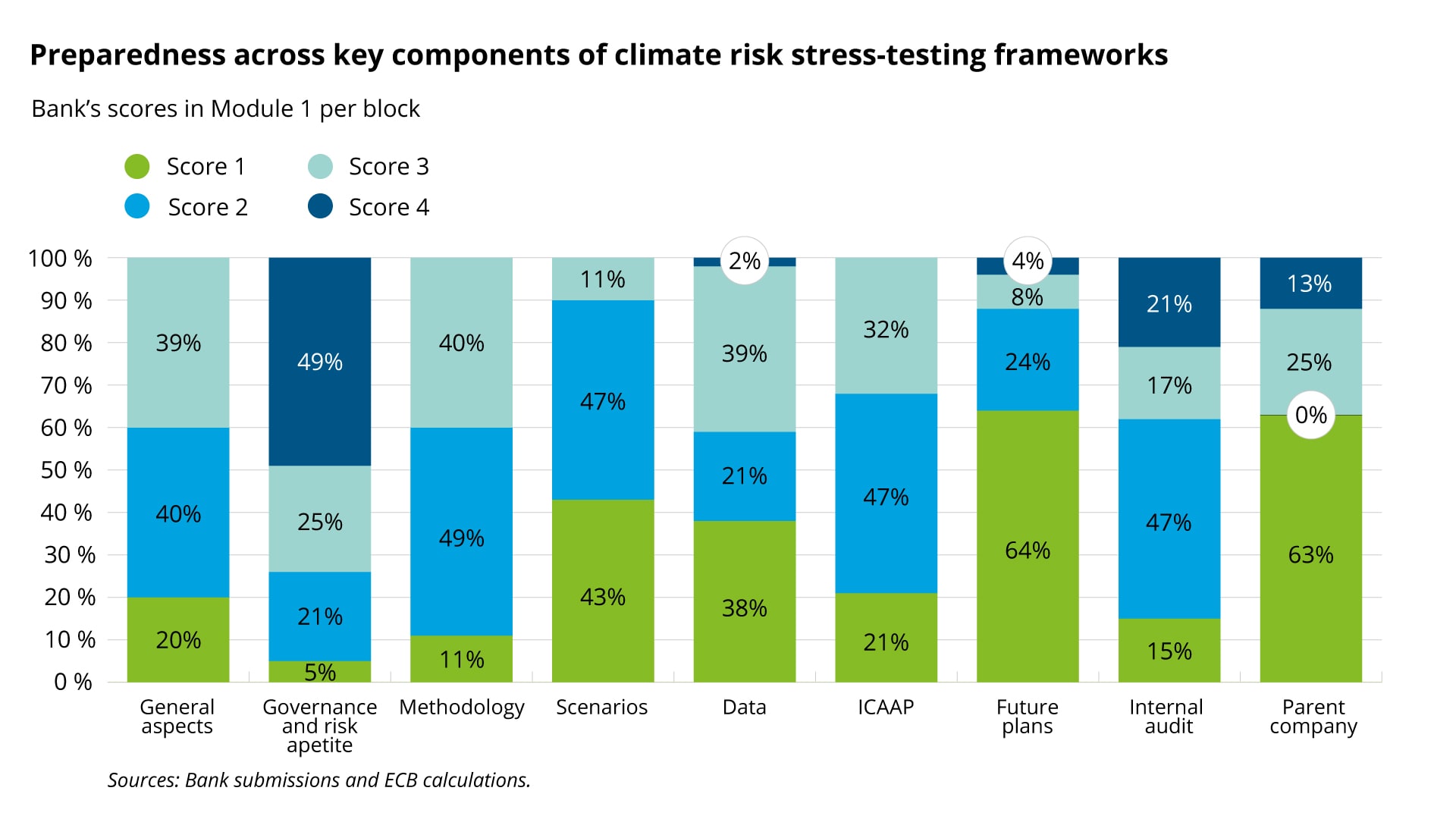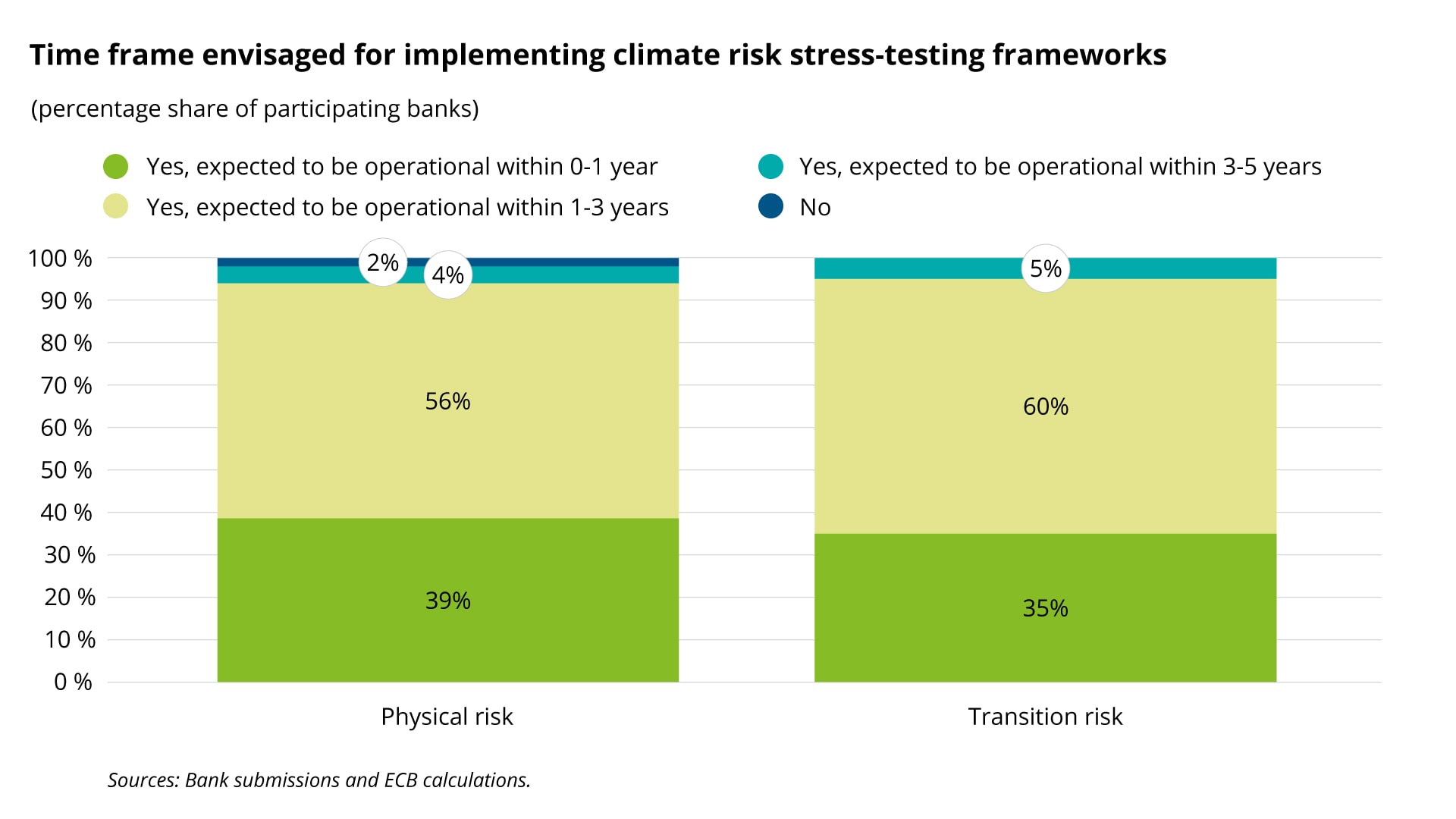On July 8th, 2022 the European Central Bank (ECB) published the results of the 2022 climate risk stress testing exercise, focusing on banks’ progress towards developing climate risk stress-testing frameworks, their capacity to produce climate risk factors and climate risk stress test projections, and the key risks faced by banks in terms of transition risks and acute physical risk events. The ECB highlighted that the 2022 climate risk stress test will not have any direct capital implications for the supervised institutions, given the exploratory nature of the exercise, the supervisory findings will feed into the annual SREP assessment only indirectly and in a qualitative way.
In their assessment, the ECB analysed qualitative and quantitative information as well, such as governance-related aspects, data availability, adequacy of transmission channels, scenario development capacity, asset class coverage, concentrations of sectoral income, financed greenhouse gas emissions and hypothetical stress test projections. The ECB published the methodology and scenarios underlying the bottom-up stress test in October 2021 and January 2022, respectively.
We have summarized below the key highlights related to ECB’s latest expectations, formulated next steps, and industry benchmarks that resulted from the 2022 climate risk stress test exercise. Deloitte can help you navigate this vast universe of ECB requirements related to climate- and environmental risks and climate risk stress testing, and we can support you in the implementation of the ECB expectations, based on our methodologies, insights, and experience from FSI ESG projects delivered for several ECB supervised banks.
Highlighted ECB expectations and next steps:
- Substantial further progress is expected in the coming years regarding data gaps, deficiencies, and inconsistencies in climate risk stress testing capabilities.

- No direct capital implications are planned at this time, supervisory findings will feed into the annual SREP assessment only indirectly and in a qualitative way.
- Bank-specific recommendations and guidance on best practices will be shared by the ECB by end of 2022, to help banks with building their internal climate risk stress-testing frameworks.
- Institutions with material climate-related and environmental exposures are expected to incorporate climate risks (both physical and transition risks) into their capital planning (incl. ICAAP) and recovery planning processes, in line with the requirements of the ECB climate-guide.
Highlighted industry benchmark results:
- Climate risks (both physical and transition) are relevant for the large majority of significant institutions directly supervised by the ECB. Most importantly:
- Banks’ income generation is heavily reliant (60% of interest income) on the top 22 sectors with the highest greenhouse gas (GHG) emissions, with estimated projected short-term risk losses in excess of EUR 70bn under a disorderly three-year transition risk scenario for the 41 banks providing projections.
- The geographical location of banks’ lending activities exposes them to varying degrees to acute physical events, namely drought and heat events and flood risk.
- Operational risks are often included in the stress-testing exercise, however this rarely included reputational risk considerations.
- Stress test results show that banks’ losses are lower in an orderly transition scenario than after delayed action.
- About 60% of banks do not yet have a well-integrated climate risk stress-testing framework, and most banks plan to have physical and/or transition climate risk included in their frameworks only on medium- to long-term.

- Around 40% of banks had a climate risk stress-testing framework in place (as of December 31, 2021), up from the November 2021 results, when 13% of institutions reported initiatives to integrate climate risks into their regular stress-testing frameworks.
- Most banks often use proxies instead of actual counterparty data for measuring Scope 1, 2 and 3 emissions. Challenges related to data availability and corporate disclosure requirements are expected to be bridged through enhanced customer engagement and collection of actual counterparty data.

- More than 50% of the banks with a climate risk stress-testing framework in place reported that climate strategies/targets for corporate counterparties and/or granular location data (e.g. location of headquarters/main manufacturing facilities) are not internally available to their relevant business areas.
- In total, 60% of the banks with a climate risk stress-testing framework in place do not currently disclose or intend to disclose any results of the climate risk stress test under Pillar III.
- Majority (75%) of banks with a climate risk stress-testing framework in place do not ensure independence between development and validation processes, and 40% of banks do not involve the internal audit function in reviewing the framework.
- Many banks indicated their aim to reduce exposures to the most GHG-emitting sectors and counterparties, however the strategies were not adapted to the different climate scenarios.

Get in touch with our experts

Ottó Sebestyén
Ottó’s experience spans across green lending, climate risk materiality assessment and stress testing, external review of ESG frameworks, credit risk assessment and risk appetite management, project management (Agile and waterfall), and designing risk management technologies for data management, exposure aggregation and credit risk workflows. Ottó joined Deloitte from Morgan Stanley where he held roles in Credit Risk and Credit Technology since 2014. Previously, Ottó worked at Citibank in financial controlling, and he holds an MSc in Investment Analysis.
